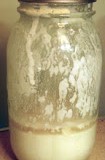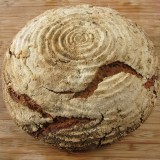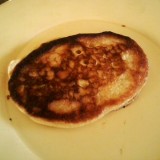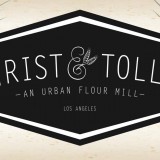
You can make bread or babies with Josey Baker’s advice. Earlier this month, the bread cult I co-founded, the Los Angeles Bread Bakers, hosted a class by author and enthusiastic bread nerd Josey Baker. Baker and his mentor Dave Miller (yes, they do have oddly appropriate surnames) have developed a style of baking that Josey has turned into set of five principles, a kind of Kama Sutra of bread: whole, wild, wet, slow and bold. Let’s get funky and break that down.
Whole
To make white flour, all the good stuff in wheat is sifted out, leaving it lifeless. Even “whole wheat” breads are made with a significant proportion of white flour. It’s been this way now for a long time. White flour, once the exclusive domain of the elite became, in the 20th century, the ubiquitous loaf of Wonder Bread many of us grew up with.
And what about that whole grain flour at the supermarket? Imagine if the only wine available in stores was wine-in-a-box, and it came in two flavors, “white” and “red.” This would be a sad world. Well, our whole grain flour choices are actually worse: there’s only one kind sold in supermarkets. Despite appearances, though, there’s actually a whole wide world of biodiversity and flavor to be found in wheat, varieties such as Kamut, Sonora, Charcoal, Triple IV, Einkorn and Red Fife, to name just a few. All are radically different in terms of color, texture and flavor. It really is analogous to wine varietals. Both Baker and Miller take advantage of grain diversity by working with farmers, milling their own flour and creating 100% whole-wheat loaves that highlight the flavor differences between wheat varieties. We’re very lucky in Los Angeles to have a retail mill, Grist & Toll, that sells many different varieties of fresh ground flour and whole grain. But, for those of you not in SoCal, check the interwebs for local millers or mail-order sources for flour and whole grains.
Wild
The wild refers to wild yeast, as in sourdough or “levain” in French. For me the best thing about working with wild yeast is that the bread has a more interesting, pronounced flavor. Another big advantage is that, due to the lactic acid producing bacteria in wild bread cultures, your bread will last a lot longer–up to a week in my experience. Lastly, though it hasn’t yet been proven, there may be some health advantages to wild starters. The lactic acid bacterias might make bread more digestible.
Wet
Both Baker and Miller mix up doughs that are surprisingly wet. Whole grain soaks up a lot of water to begin with, but both Baker and Miller push that wetness to very high hydration levels: sometimes in the neighborhood of 120% hydration if you’re keeping score. (N.B. Hydration level refers to the ratio of water to flour by weight: 100 grams of flour mixed with 100 grams of water = 100% hydration) A big advantage of wet dough is that you don’t need to knead it. The gluten strands align on their own in the wet dough matrix. You still have to do some stretching and folding to help the gluten alignment process along, but you don’t have anything that resembles traditional kneading. Very wet doughs have the disadvantage of being difficult to turn into hearth loaves. Dave Miller overcomes this by his almost supernatural ability to shape dough. It’s almost like he can just stare at a pile of what looks like pancake batter and miraculously turn it into neat little boules. Baker had a great tip for those of us not as adept at forming loaves out of wet dough: just bake your bread in a loaf pan. Problem solved! I’ve been doing a lot lately.
Slow
The refrigerator is your friend. Doing some part of the fermentation in the fridge lengthens the fermentation time and helps develop more pronounced flavors. It also allows greater flexibility in your baking schedule. Got to go to work? Pick up the kids? No problem. Put that dough in the fridge. Baker likes to do the bulk fermentation (e.g. the first fermentation) at room temperature, shape the loaves, and then proof them in the fridge. They can then come straight out of the fridge and into the oven. Miller, due to some quirks in his schedule, likes to do the latter part of the bulk fermentation in the fridge, shape the loaves and then proof them at room temperature. One advantage with Miller’s approach is that cold dough is easier to shape. Personally, for reasons I can’t quite explain, I’ve had more luck with bulk fermentation at room temperature and proofing in the fridge.
Bold
One of the biggest mistakes newbie bakers make is puling their loaves out of the oven before the bread is really, truly done. Both Miller and Baker leave their loaves in the oven until they are almost burnt. The reasons are multiple. Take the loaf out too soon and, particularly with whole grain breads, the crust will be too soft. Another reason is that Miller contends that the sort of whole grain breads you buy at the supermarket are under-baked. Poke the center of those commercial breads and the texture is often like play dough. Plus, I’d say, those boldly baked loaves are pretty.
Josey Baker’s formula is simple: find an interesting grain, ferment it with a sourdough starter with a lot of water, use the refrigerator to your advantage and bake it to the edge of being burnt. The details of this process will be the subject of future posts.




Hi!
My boyfriend and I loved your prickly pear jelly recipe from a few years ago! We’ve recently started our own adventure blog and shared how we used your recipe and gave you full credit. Keep up the great posts and check it out if you’d like!
Thanks!
http://www.friedpicklez.com
I bought Josey Baker’s book last year(s?) at your suggestion and I have finally (FINALLY) been able to get a sourdough starter to work. I like that he uses a small amounts of flour and suggests composting the leftovers (tip: wrap the waste in newspaper, it’s easier to handle and doesn’t muck up your bucket), which is perfect for home bakers. I live in South TX and our heat makes room-temp fermentation a tricky endeavour which is never properly addressed in most bread books, strangely enough. My mother always talks about how TX has different rules for gardening, full sun and whatnot, so I just applied it to sourdough and it worked. I started in October and fed my starter twice a day, once before bed and then again when I woke up and it started to work. I actually baked my first sourdough loaf last night and I very nearly cried, it was lightly sour and had that wonderful chew of wild yeast. I did, however, add 2 TBS of starter to my single loaf instead of 1 TBS and it worked beautifully. So thank you for the recommendation, I can’t wait to cook my way through his book.
P.S.
Josey’s Sesame Loaf using regular yeast is a revelation. It is so incredibly good that I happily stalled making a sourdough starter because I was so satisfied with that loaf. Anyone who is interested, but intimidated to bake with wild yeast should definitely start with this book and start with that loaf and work their way through the rest.
” bread or babies” I should not eat so much bread and am long past baby-bearing age. So, I will just pretend I can still make babies and practice. I hate kneading bread, anyway.